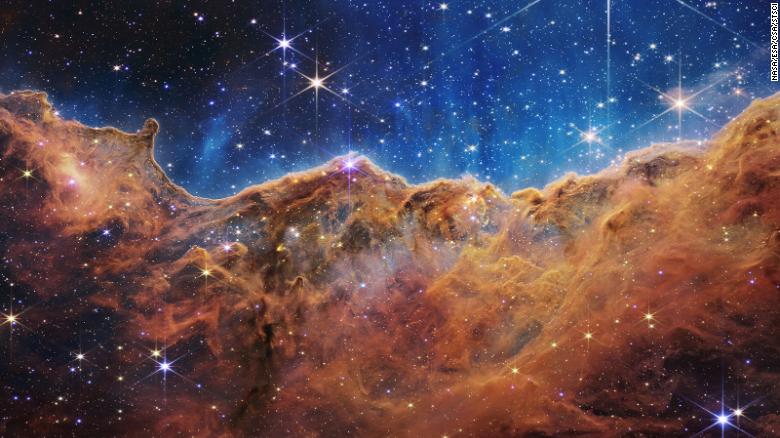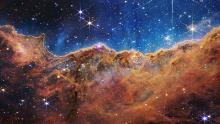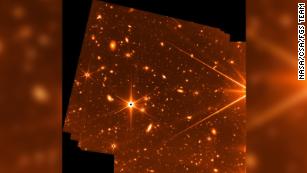NASA reveals the Webb telescope’s new images of stars, galaxies and an exoplanet
By Ashley Strickland, CNN
Wed July 13, 2022
Photos: Observing the universe with the James Webb Space TelescopeThis side-by-side comparison shows observations of the Southern Ring Nebula in near-infrared light, left, and mid-infrared light, right, from NASA’s Webb telescope. The Southern Ring Nebula is 2,000 light-years away from Earth. This large planetary nebula includes an expanding cloud of gas around a dying star, as well as a secondary star earlier on in its evolution. Hide Caption3 of 5
Photos: Observing the universe with the James Webb Space TelescopeWebb spied the steamy atmosphere of exoplanet WASP-96 b, located 1,150 light-years away. Webb’s spectrum found a distinct signature of water, along with evidence of clouds and haze. It is the most detailed spectrum of an exoplanet to date. Hide Caption4 of 5
Photos: Observing the universe with the James Webb Space TelescopePresident Joe Biden released one of Webb’s first images on Monday, July 11. The image of SMACS 0723 is “the deepest and sharpest infrared image of the distant universe to date,” according to NASA. Hide Caption5 of 5

Photos: Observing the universe with the James Webb Space TelescopeWebb’s landscape-like view, called “Cosmic Cliffs,” is actually the edge of a nearby, young, star-forming region called NGC 3324 in the Carina Nebula. The telescope’s infrared view reveals previously invisible areas of star birth. Hide Caption1 of 5
Photos: Observing the universe with the James Webb Space TelescopeThe five galaxies of Stephan’s Quintet can be seen here in a new light. This is Webb’s largest image yet, containing over 150 million pixels. These galaxies appear to dance with one another, showcasing how these interactions can drive galactic evolution. Hide Caption2 of 5
Photos: Observing the universe with the James Webb Space TelescopeThis side-by-side comparison shows observations of the Southern Ring Nebula in near-infrared light, left, and mid-infrared light, right, from NASA’s Webb telescope. The Southern Ring Nebula is 2,000 light-years away from Earth. This large planetary nebula includes an expanding cloud of gas around a dying star, as well as a secondary star earlier on in its evolution. Hide Caption3 of 5
Photos: Observing the universe with the James Webb Space TelescopeWebb spied the steamy atmosphere of exoplanet WASP-96 b, located 1,150 light-years away. Webb’s spectrum found a distinct signature of water, along with evidence of clouds and haze. It is the most detailed spectrum of an exoplanet to date. Hide Caption4 of 5
Photos: Observing the universe with the James Webb Space TelescopePresident Joe Biden released one of Webb’s first images on Monday, July 11. The image of SMACS 0723 is “the deepest and sharpest infrared image of the distant universe to date,” according to NASA. Hide Caption5 of 5

Photos: Observing the universe with the James Webb Space TelescopeWebb’s landscape-like view, called “Cosmic Cliffs,” is actually the edge of a nearby, young, star-forming region called NGC 3324 in the Carina Nebula. The telescope’s infrared view reveals previously invisible areas of star birth. Hide Caption1 of 5
Photos: Observing the universe with the James Webb Space TelescopeThe five galaxies of Stephan’s Quintet can be seen here in a new light. This is Webb’s largest image yet, containing over 150 million pixels. These galaxies appear to dance with one another, showcasing how these interactions can drive galactic evolution. Hide Caption2 of 5
Photos: Observing the universe with the James Webb Space TelescopeThis side-by-side comparison shows observations of the Southern Ring Nebula in near-infrared light, left, and mid-infrared light, right, from NASA’s Webb telescope. The Southern Ring Nebula is 2,000 light-years away from Earth. This large planetary nebula includes an expanding cloud of gas around a dying star, as well as a secondary star earlier on in its evolution. Hide Caption3 of 5




Sign up for CNN’s Wonder Theory science newsletter. Explore the universe with news on fascinating discoveries, scientific advancements and more.
(CNN)A stellar nursery where stars are born, interactions between galaxies and a unique view of an exoplanet are just some of the new cosmic images shared Tuesday. After decades of waiting, it’s finally time for the world to see the first images taken by the most powerful space telescope ever — the James Webb Space Telescope. Development of the world’s premier space observatory began in 2004, and after years of delays, the telescope and its massive gold mirror finally launched on December 25.
The images are worth the wait — and they will forever change the way we see the universe. President Joe Biden released one of Webb’s first images on Monday, and it is “the deepest and sharpest infrared image of the distant universe to date,” according to NASA. The rest of the high-resolution colour images made their debut on Tuesday.

Opinion: New space photos will reveal secrets of the universe space observatory can investigate the mysteries of the universe by observing them through infrared light, which is invisible to the human eye. Webb will peer into the very atmospheres of exoplanets, some of which are potentially habitable, and it could uncover clues in the ongoing search for life outside of Earth.
The telescope will also look at every phase of cosmic history, including the first glows after the big bang that created our universe and the formation of the galaxies, stars and planets that fill it today. Now, Webb is ready to help us understand the origins of the universe and begin to answer key questions about our existence, such as where we came from and if we’re alone in the cosmos.
The first images
The first image, released on Monday, shows SMACS 0723, where a massive group of galaxy clusters act as a magnifying glass for the objects behind them. Called gravitational lensing, this created Webb’s first deep field view that includes incredibly old and faint galaxies.

The image of SMACS 0723 is “the deepest and sharpest infrared image of the distant universe to date,” according to NASA. Some of these distant galaxies and star clusters have never been seen before. The galaxy cluster is shown as it appeared 4.6 billion years ago. The image, taken by Webb’s Near-Infrared Camera, is composed of images taken at different wavelengths of light over a collective 12.5 hours.
Deep field observations are lengthy observations of regions of the sky that can reveal faint objects. Webb’s other primary targets for the first image release included the Carina Nebula, WASP-96 b, the Southern Ring Nebula and Stephan’s Quintet. Webb’s study of the giant gas planet WASP-96 b is the most detailed spectrum of an exoplanet to date. The spectrum includes different wavelengths of light that reveal new information about the planet and its atmosphere. Discovered in 2014, WASP-96 b is located 1,150 light-years from Earth. It has half the mass of Jupiter and completes an orbit around its
star every 3.4 days.
NASA’s James Webb Space Telescope captured a spectrum of WASP-96 b. Webb’s spectrum includes “the distinct signature of water, along with evidence for clouds and haze, in the atmosphere surrounding a hot, puffy gas giant planet orbiting a distant Sun-like star,” according to NASA. The observation demonstrates “Webb’s unprecedented ability to analyze atmospheres hundreds of light-years away,” according to NASA. In the future, Webb will capture actual images of known exoplanets while also searching for unknown planets, said Knicole Colón, Webb’s deputy project scientist for exoplanet science at NASA’s Goddard Space Flight Center, during a news conference.
And the spectrum of WASP-96 b is “barely scratching the surface of what we’re going to learn.”Colón anticipates that scientists will determine just how much water is in the exoplanet’s atmosphere. The Southern Ring Nebula, also called the “Eight-Burst,” is 2,000 light-years away from Earth. This large planetary nebula includes an expanding cloud of gas around a dying star. Webb helped reveal previously hidden details about the nebula, which is a shell of gas and dust released by the dying star. The nebula’s second star can be seen in the Webb image, as well as how the stars shape the gas and dust cloud.


NASA second star is surrounded by dust while the brighter star, at an earlier stage of evolution, will release its own cloud of gas and dust later on. As the two stars orbit one another, they effectively “stir” the gas and dust, resulting in the patterns seen in the image. The insights from images like this could help astronomers to unlock how stars change their environments as they evolve. Multi-coloured points of light in the background represent galaxies.
The space telescope’s view of Stephan’s Quintet shows the way galaxies interact with one another. This compact galaxy group, first discovered in 1787, is located 290 million light-years away in the constellation Pegasus. Four of the five galaxies in the group “are locked in a cosmic dance of repeated close encounters,” according to a NASA statement.


NASA you’ve ever watched “It’s a Wonderful Life,” you’ve seen Stephan’s Quintet. Now, Webb has revealed the galactic grouping in a new mosaic which is the telescope’s largest image to date.” The information from Webb provides new insights into how galactic interactions may have driven galaxy evolution in the early universe,” according to NASA. The Stephan’s Quintet image provides a rare glimpse into how galaxies can trigger star formation in one another when they interact, as well as outflows driven by a black hole at a new level of detail.
The gravitational dance between these galaxies can be seen through tails of gas, dust and stars and even shock waves as one of the galaxies pushes through the cluster. Located 7,600 light-years away, the Carina Nebula is a stellar nursery, where stars are born. It is one of the largest and brightest nebulae in the sky and home to many stars much more massive than our sun. Now, its “Cosmic Cliffs” are revealed in an incredible new Webb image.


NASAWebb’s ability to see through cosmic dust has revealed previously invisible areas of star birth within the nebula, which could provide new insight into the formation of stars. The earliest stages of star formation are harder to capture — but something Webb’s sensitivity can chronicle. What looks like a landscape in the image is really a massive gaseous cavity with “peaks” reaching 7 light-years high.
“The cavernous area has been carved from the nebula by the intense ultraviolet radiation and stellar winds from extremely massive, hot, young stars located in the centre of the bubble, above the area shown in this image,” according to NASA. And what looks like “steam” rising off the “mountains” is hot, energetic gas and dust. The targets were selected by an international committee, including members from NASA, the European Space Agency, the Canadian Space Agency and the Space Telescope Science Institute in Baltimore.

I’m a little verklempt’: Analyst breaks down stunning new Webb telescope images 03:50
A long future of observation
The mission, originally expected to last for 10 years, has enough excess fuel capability to operate for 20 years, according to NASA Deputy Administrator Pam Melroy. These will be just the first of many images to come from Webb over the next two decades, which promise to fundamentally alter the way we understand the cosmos.
While some of what Webb could reveal has been anticipated, the unknowns are just as exciting to scientists.” We don’t know what we don’t know yet,” said Amber Straughn, Webb’s deputy project scientist for communications at NASA Goddard. “I think it’s true that every time we launch a revolutionary instrument into space, like with Hubble, we learn things that completely surprise us but do cause us to sort of change our fundamental understanding of how the universe works.”Hubble’s 31 years have yielded a wealth of discoveries that couldn’t be anticipated, and the scientific community views Webb and its capabilities in the same way.
When comparing Webb’s first images to other breakthroughs in astronomy, Webb program scientist and NASA Astrophysics Division chief scientist Eric Smith compared it to seeing Hubble’s images after the telescope was repaired and everything snapped into focus.”A lot of people sometimes see pictures of space and they think it makes them feel small,” Smith said. “When I see these pictures, they make me feel powerful.
A team of people can make this unbelievable instrument to find out things about the universe revealed here, and just seeing that pride in the team, and pride in humanity, that when we want to, we can do that.”The universe has (always) been out there,” said Jane Rigby, Webb operations project scientist at NASA Goddard.
“We just had to build a telescope to go see what was there. Yeah, a very similar feeling of, maybe, people in a broken world managing to do something right and to see some of the majesties that are out there.”
- https://www.cnn.com/2022/07/12/world/james-webb-space-telescope-new-images-scn/index.html
——————————————————————————————————————–
உலகையே திரும்பி பார்க்க வைத்த நாசாவின் “ஜேம்ஸ் வெப்’
சாதனையை சிறப்பிக்கும் கூகுள் டூடுள் வெளியீடு பூமியில் இருந்து பல லட்சம் மைல்கள் தொலைவில் நிலை நிறுத்தப்பட்டுள்ள ஜேம்ஸ் வெப்தொலைநோக்கி, பிரபஞ்சத்தை அற்புதமாக படம் பிடித்திருப்பதை நாசா வெளியிட்டது. உலகையே திரும்பி பார்க்க வைத்த நாசாவின் “ஜேம்ஸ் வெப்’ விண்வெளி தொலைநோக்கியின் இந்த சாதனையை சிறப்பிக்கும்
விதமாக கூகுள் நிறுவனம் தனது முகப்புப் பக்கத்தில் டூடுல் வெளியிட்டு சிறப்பித்துள்ளது.ஐரோப்பா, கனடா விண்வெளி ஆய்வு அமைப்புகளுடன் இணைந்து “ஜேம்ஸ் வெப்’ என்ற விண்வெளி தொலைநோக்கியை
ரூ.79.6 ஆயிரம் கோடியில் நாசா உருவாக்கியது. உலகின் மிகப் பெரிய இந்த தொலைநோக்கி, தென் அமெரிக்காவின் பிரெஞ்ச் கயானாவில் உள்ள ரொக்கெட் ஏவுதளத்தில் இருந்து 5 ரொக்கெட்டுகள் மூலம் கடந்த
டிசெம்பர் மாதம் வெற்றிகரமாக விண்ணில் செலுத்தப்பட்டது.
பூமியில் இருந்து 10 லட்சம் மைல் தொலைவில் நிலை நிறுத்தப்பட்டுள்ள ஜேம்ஸ் வெப் தொலைநோக்கி எடுத்து அனுப்பிய பிரபஞ்சத்தின் முதலாவது
வண்ணப்படத்தை அதிபர் பைடன் வெள்ளை மாளிகையில் வெளியிட்டார். இதற்குமுன் இப்படிப்படம் எடுக்கப்பட்டது இல்லை. இதில், “பிரபஞ்சம் வெள்ளை, மஞ்சள், ஆரஞ்சு மற்றும் சிவப்பு நிறங்களில் புள்ளிகள்,
கோடுகள், சுருள்கள், சூழல்கள் என வண்ணமயமாக காட்சி அளிக்கிறது,’ என்று நாசா நிர்வாகி பில் நெல்சன் கூறியுள்ளார். இந்த நிலையில் இன்றைய கூகுளின் முகப்பு பக்கத்தில் நாசாவின் ஜேம்ஸ் வெப் தொலைநோக்கியும், அதன் மூலம் எடுக்கப்பட்ட பிரபஞ்சத்தின் படங்களும் இடம்பெற்றுள்ளன.
——————————————————————————————————————–

Leave a Reply
You must be logged in to post a comment.